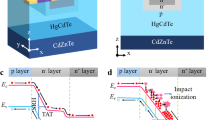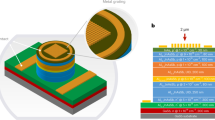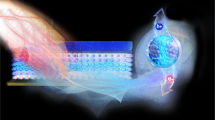Abstract
The spectral response of common optoelectronic photodetectors is restricted by a cutoff wavelength limit λc that is related to the activation energy (or bandgap) of the semiconductor structure (or material) (Δ) through the relationship λc = hc/Δ. This spectral rule dominates device design and intrinsically limits the long-wavelength response of a semiconductor photodetector. Here, we report a new, long-wavelength photodetection principle based on a hot–cold hole energy transfer mechanism that overcomes this spectral limit. Hot carriers injected into a semiconductor structure interact with cold carriers and excite them to higher energy states. This enables a very long-wavelength infrared response. In our experiments, we observe a response up to 55 µm, which is tunable by varying the degree of hot-hole injection, for a GaAs/AlGaAs sample with Δ = 0.32 eV (equivalent to 3.9 µm in wavelength).
This is a preview of subscription content, access via your institution
Access options
Subscribe to this journal
Receive 12 print issues and online access
$209.00 per year
only $17.42 per issue
Buy this article
- Purchase on Springer Link
- Instant access to full article PDF
Prices may be subject to local taxes which are calculated during checkout




Similar content being viewed by others
References
Freitag, M., Low, T., Xia, F. & Avouris, P. Photoconductivity of biased graphene. Nature Photon. 7, 53–59 (2013).
Gabor, N. M. et al. Hot carrier-assisted intrinsic photoresponse in graphene. Science 334, 648–652 (2011).
Sun, Z. et al. Infrared photodetectors based on CVD-grown graphene and PbS quantum dots with ultrahigh responsivity. Adv. Mater. 24, 5878–5883 (2012).
Yan, J. et al. Dual-gated bilayer graphene hot-electron bolometer. Nature Nanotech. 7, 472–478 (2012).
Rossi, F. & Kuhn, T. Theory of ultrafast phenomena in photoexcited semiconductors. Rev. Mod. Phys. 74, 895–950 (2002).
Winnerl, S. et al. Carrier relaxation in epitaxial graphene photoexcited near the Dirac point. Phys. Rev. Lett. 107, 237401 (2011).
Rosenwaks, Y. et al. Hot-carrier cooling in GaAs: quantum wells versus bulk. Phys. Rev. B 48, 14675–14678 (1993).
Jalabert, R. & Das Sarma, S. Inelastic scattering in a doped polar semiconductor. Phys. Rev. B 41, 3651–3654 (1990).
Petersen, C. L. & Lyon, S. A. Observation of hot-electron energy loss through the emission of phonon–plasmon coupled modes in GaAs. Phys. Rev. Lett. 65, 760–763 (1990).
Sicault, D., Teissier, R., Pardo, F., Pelouard, J.-L. & Mollot, F. Experimental study of hot-electron inelastic scattering rate in p-type InGaAs. Phys. Rev. B 65, 121301 (2002).
Xiao, J. et al. Carrier multiplication in semiconductor nanocrystals detected by energy transfer to organic dye molecules. Nature Commun. 3, 1170 (2012).
Capasso, F. Band-gap engineering: from physics and materials to new semiconductor devices. Science 235, 172–176 (1987).
Kang, Y. et al. Monolithic germanium/silicon avalanche photodiodes with 340 GHz gain–bandwidth product. Nature Photon. 3, 59–63 (2009).
Sze, S. M. & Ng, K. K. Physics of Semiconductor Devices (Wiley, 2007).
Lao, Y.-F. & Perera, A. G. U. Temperature-dependent internal photoemission probe for band parameters. Phys. Rev. B 86, 195315 (2012).
Rinzan, M. B. M. et al. AlGaAs emitter/GaAs barrier terahertz detector with a 2.3 THz threshold. Appl. Phys. Lett. 86, 071112 (2005).
Perera, A. G. U. et al. GaAs multilayer p+-i homojunction far-infrared detectors. J. Appl. Phys. 81, 3316–3319 (1997).
Matsik, S. G. et al. Cutoff tailorability of heterojunction terahertz detectors. Appl. Phys. Lett. 82, 139–141 (2003).
Chapler, B. C. et al. Infrared probe of the insulator-to-metal transition in Ga1– xMnxAs and Ga1– xBexAs. Phys. Rev. B 84, 081203 (2011).
Lao, Y.-F. & Perera, A. G. U. Dielectric function model for p-type semiconductor inter-valence band transitions. J. Appl. Phys. 109, 103528 (2011).
Newman, R. & Tyler, W. W. Effect of impurities on free-hole infrared absorption in p-type germanium. Phys. Rev. 105, 885–886 (1957).
Schneider, H. & Liu, H. C. Quantum Well Infrared Photodetectors: Physics and Applications (Springer Series in Optical Sciences 126, Springer, 2007).
Hayes, J. R., Levi, A. F. J. & Wiegmann, W. Hot-electron spectroscopy of GaAs. Phys. Rev. Lett. 54, 1570–1572 (1985).
Levi, A. F. J., Hayes, J. R., Platzman, P. M. & Wiegmann, W. Injected-hot-electron transport in GaAs. Phys. Rev. Lett. 55, 2071–2073 (1985).
Thibaudeau, L., Bois, P. & Duboz, J. Y. A self-consistent model for quantum well infrared photodetectors. J. Appl. Phys. 79, 446–454 (1996).
Woerner, M., Elsaesser, T. & Kaiser, W. Relaxation processes of hot holes in p-type germanium studied by picosecond infrared spectroscopy. Phys. Rev. B 45, 8378–8387 (1992).
Elsaesser, T. et al. Relaxation processes of hot holes in Ge and GaAs investigated by ultrafast infrared spectroscopy. Semicond. Sci. Technol. 9, 689–693 (1994).
Lao, Y.-F. et al. Direct observation of spin–orbit splitting and phonon-assisted optical transitions in the valence band by internal photoemission spectroscopy. Phys. Rev. B 88, 201302 (2013).
Esaev, D. G., Rinzan, M. B. M., Matsik, S. G. & Perera, A. G. U. Design and optimization of GaAs/AlGaAs heterojunction infrared detectors. J. Appl. Phys. 96, 4588–4597 (2004).
Brill, B. & Heiblum, M. Electron heating in GaAs due to electron–electron interactions. Phys. Rev. B 49, 14762–14765 (1994).
Blakemore, J. S. Semiconducting and other major properties of gallium arsenide. J. Appl. Phys. 53, R123 (1982).
Matthews, M. R. et al. Transient photoconductivity measurements of carrier lifetimes in an InAs/In0.15Ga0.85As dots-in-a-well detector. Appl. Phys. Lett. 90, 103519 (2007).
Chen, J. et al. Hybrid organic/inorganic optical up-converter for pixel-less near-infrared imaging. Adv. Mater. 24, 3138–3142 (2012).
Sang, L., Hu, J., Zou, R., Koide, Y. & Liao, M. Arbitrary multicolor photodetection by hetero-integrated semiconductor nanostructures. Sci. Rep. 3, 2368 (2013).
Acknowledgements
This work was supported in part by the US Army Research Office (grant no. W911NF-12-2-0035), monitored by William W. Clark, and in part by the US National Science Foundation (grant no. ECCS-1232184, monitored by John M. Zavada). The University of Leeds acknowledges supports from the UK Engineering and Physical Sciences Research Council and E.H.L. from the European Research Council Advanced Grant ‘TOSCA’. Authors wish to dedicate this paper to the memory of Dr. H. C. Liu (H.C. as he was universally known). H.C. was an integral part of this work, and was inspirational to generations of researcher.
Author information
Authors and Affiliations
Contributions
A.G.U.P. conceived the split-off heterojunction concept and was involved in designing the device structure. Y.F.L. and A.G.U.P. conceived the experiments and wrote the paper. L.H.L., S.P.K. and E.H.L. grew the samples using molecular beam epitaxy. H.C.L. carried out the device processing. Y.F.L. performed electrical and optical measurements and data analysis. A.G.U.P. guided the project. All authors contributed to the content in the paper.
Corresponding author
Ethics declarations
Competing interests
The authors declare no competing financial interests.
Supplementary information
Supplementary information
Supplementary information (PDF 614 kb)
Rights and permissions
About this article
Cite this article
Lao, YF., Perera, A., Li, L. et al. Tunable hot-carrier photodetection beyond the bandgap spectral limit. Nature Photon 8, 412–418 (2014). https://doi.org/10.1038/nphoton.2014.80
Received:
Accepted:
Published:
Issue Date:
DOI: https://doi.org/10.1038/nphoton.2014.80
This article is cited by
-
Direct observation of significant hot carrier cooling suppression in a two-dimensional silicon phononic crystal
NPG Asia Materials (2022)
-
Ultrafast hot carrier transfer in WS2/graphene large area heterostructures
npj 2D Materials and Applications (2022)
-
Broadband THz to NIR up-converter for photon-type THz imaging
Nature Communications (2019)
-
Enhanced hot electron lifetimes in quantum wells with inhibited phonon coupling
Scientific Reports (2018)
-
Hot carrier cooling mechanisms in halide perovskites
Nature Communications (2017)



